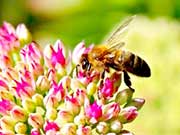|
|
 |
 |
OSU Extension
Be Mindful of
Honeybees and Other Pollinators During Planting
Reed Johnson, Kelley Tilmon, Andy Michel
The winter of 2017-2018 is destined to go down in Ohio beekeeping
history as one of the worst on record. In October, the OSU honey
bee lab had 50 living colonies, but by the beginning of April, we were
down to just 5 survivors. While some of these honey bee colonies died
as a result of the exceptionally long, cold winter, more than half of
our losses occurred before the first snow fell in November 2017.
In talking with other beekeepers around the state it has become clear
that 90% losses were typical for many beekeepers this year. To
replace lost colonies we’ve spent $130 per hive to purchase boxes of
bees imported to Ohio from Georgia or California. These new
colonies should thrive and grow on the bountiful dandelions, mints,
mustards and fruit trees of spring. With luck, the populations of
colonies will soon be large enough that they will be able to make a
honey crop off of clovers, black locust, alfalfa and soybean in the
coming months. Some beekeepers will then move their colonies into
pumpkins or cucumbers later in the summer.
But spring build-up of these young, expensive bee colonies is critical,
and early May is the most important period. Unfortunately, colony
growth can be directly threatened by corn planting. Insecticide
seed treatments used on corn seed generate an insecticidal dust when
they are planted. Bees may encounter a cloud of insecticidal dust
as they cross corn fields to visit the dandelions and blooming trees in
field margins. Insecticidal seed treatment dust can also settle
on these flowers that bees are visiting. Insecticide dusts are
particularly harmful for honey bees because they do not immediately
kill the adult foraging bees that encounter the insecticide. Instead,
the dust is packed up with the pollen by the forager and brought back
to the colony where it is fed to young bees. So it is the future
workforce for the colony that is hit hardest by corn planting-related
seed treatment dust.
Several years ago, in spring of 2015, we sampled pollen from ten bee
yards in the counties west of Columbus. During corn planting, all
colonies were bringing back pollen containing corn seed treatment
insecticides. While no spectacular bee-kills were observed in our
colonies, we did observe a significant increase in the number of dead
bees appearing in front of colonies during the week of corn planting in
2015.
Honey bee exposure to seed treatment dust during corn planting can be
reduced by 1) starting with clean and weed-free fields that are
uninteresting to honey bees; 2) following recommendations for using
talc or other seed lubricants; 3) following proper planter clean-out
and disposal procedures when finished to minimize escape of seed
treatment dust.
|
|
|
|

